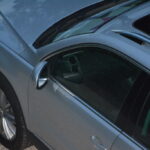Is it Safe (and Legal) to Drive Barefoot?
You spend a good time on the beach with your friends and family, and now you are headed home. Your shoes are filled with sand, and you do not want to put them on just to drive. Is that legal? But moreover, is it safe to do so? This article will help you find a definitive answer to those questions.
Is it Safe to Drive Barefoot?
It depends on what the alternative option is. Is it safer than driving while wearing regular shoes with a sole of average thickness? Absolutely not. Driving while wearing shoes has several advantages of its own, and it is almost always safer than driving barefoot.
But that changes when we consider the case of designer shoes or work boots. These shoes with high heels or thick soles will hamper the driver’s ability to precisely control the throttle and brake input. The ankle and knee-high boots will also restrict ankle movement, slowing down reaction time and increasing the risk of crashing.
Wearing high-heeled shoes will force you to keep your foot at an uncomfortable angle to press the pedals. This can be very uncomfortable and over a long distance. It can cause fatigue, which will further deteriorate your ability to drive safely.
Shoes with thick soles will be heavier, so you might not have as much control over their movement. It will also be difficult to move from one pedal to another with thick and wide soles. And you may not be able to accurately judge how far you have pressed the pedal.
High-top boots will limit how much you can twist your ankles to either side. To drive a car, you should be able to freely move your leg between the brake and accelerator without taking the balls of your feet off the ground. It will adversely affect your ability to react to sudden obstacles on the road.
Taking these factors into consideration, we can conclude that, if the footwear you are wearing limits or interferes with your ability to maneuver the car effectively, you might be better off not wearing those shoes after all.
But driving barefoot comes with its own set of disadvantages and concerns. You should be able to weigh the pros and cons to figure out what will work for you.
Also read: Why is Your Car so Dusty Inside? (Solution)
Why is it Bad to Drive Barefoot?
Driving barefoot is not a good idea due to several reasons. The foot can become wet from perspiration, which will decrease the amount of grip available for pressing the pedals.
Your foot might slip off the pedal as you are applying more and more pressure. And if that happens to be the brake pedal, the car will not stop as you might have intended. Instead, it would have collided with whatever object lied ahead. And it goes without saying that this can end in a catastrophic situation.
If you drive a manual vehicle, this is also applicable for the clutch pedal. The sudden release of the clutch pedal can cause the car to stall, and in the worst-case scenario, it can cause damage to the transmission components.
Also read: 10 Cars Under $20K that Look Like They’re for $50K+
Also, the clutch is a relatively small pedal without much surface area. And in many cars, especially the older ones, require quite a hefty amount of pressure to engage and disengage the clutch.
If the driver is wearing a shoe with a relatively flat sole, it will distribute this force over a much larger surface area. It will decrease the amount of pressure being applied directly at the balls of their feet, which will have a significant impact on the fatigue caused by prolonged driving.
Repeatedly exerting a lot of pressure to operate the clutch can be painful, and over a long period, it might cause cramps and spasms to develop in that leg. It can also cause the formation of minor blisters. All of which will decrease your ability to operate the clutch efficiently.
Trending Video: How to Easily Bring Back to Life any Old Car Battery and Save Tons of Money (click to watch)
So if you are going to drive a manual car for a prolonged period, you might have to consider keeping your shoes on for most of the ride.
In the unfortunate event of a crash, a good pair of shoes will protect your foot from a lot of damage. During collisions, your foot might get banged against hard surfaces, or it might come in contact with debris such as broken pieces of glass or even metal bits that came off the car.
It can save your feet from severe burns or electrical shocks as well. So, wearing a shoe might ensure that your feet do not sustain any major injuries if you ever find yourself in a tricky situation on the road.
Can You Get a Fine for Driving Barefoot?
Driving a car barefoot is not a punishable offense in most countries. Consult with your local authorities just to make sure that they are on the same page. However, riding motorcycles without wearing proper footwear is an exception. As your feet are exposed to the elements, several countries mandate the use of proper footwear while riding a motorcycle.
But all road and safety authorities strongly recommend against driving barefoot. If driving barefoot turns out to be the cause of an accident, the competent authority can charge you with negligent driving for driving without wearing proper footwear. But that is only if they can prove that you’re driving barefoot directly contributed to causing the accident.
If you are found guilty of negligent driving, your insurance claims may also take a big hit. So the consensus is that driving barefoot should not cause any harm to others’ health or properties. If it does not in any way interfere with your ability to drive safely, then the authorities do not have any valid grounds to impose fines or other punishments.
Also read: How to Cope with Running Over an Animal (8 Easy Tips)
When is it Recommended to Drive Barefoot?
Not a lot of research or studies have been conducted to validate any claims regarding driving barefoot. And the rule of thumb should be to always drive in a manner that makes you feel confident.
You might have gotten used to the negatives that were mentioned above, and wearing shoes might actually interfere with your ability to operate the pedals. If that is the case, then there is nothing to stop you from doing that.
Another scenario where you might want to consider driving barefoot is when you are wearing shoes that are not fit for driving. Designer shoes such as high heels, platform shoes, and ankle/knee-high boots, or work boots such as gumboots and other thick-soled shoes are not ideal for driving.
Also read: 15 Cars that NEVER Rust (100% Galvanised)
Is Driving with Socks Better than Driving Barefoot?
It’s far worse because the problem with driving barefoot is the low amount of grip and the huge amount of force being applied on a small surface area. Wearing socks will not help with either of the problems, but it will actually further decrease the available grip.
It might help with your foot rubbing on the pedals and forming blisters, but it is not worth the additional risk. The pedal might slip out from under your foot at any time if you try to press it while wearing socks. The socks can also get snagged by pointy edges in the footwell, and it will not be a pleasant experience if it gets stuck.
Are There Any Benefits of Driving Barefoot?
Many drivers feel that they can better modulate the clutch and brake pedals when they drive barefoot. A lot of it boils down to your driving habits that were formed through years of driving. Also, you might be able to get a better feel for the pedals while driving barefoot.
It might also be more comfortable, but that also depends mostly on personal preferences. Other than that, there are not a lot of benefits to gain from driving barefoot.
What’s the Maximum Distance You Should Drive Barefoot?
There is no maximum distance that works for everybody. It varies from person to person. If you have formed a habit of driving barefoot, then it will be easier for you to drive barefoot over long distances.
But if you are not used to it, you can drive barefoot as long as you feel comfortable with it and as long as it does not affect your driving.
Also read: What Happens if You Shift from 5th Gear to 1st?
Tips on How to Drive Barefoot Safely
Keep the footwell clear of any mud, sand, or any other debris. If the pedals are muddy, your foot might slip off, and the sand can become uncomfortable.
Also, if you remove your shoes, do not leave them in the driver’s side footwell. It will move under braking and acceleration, and it might get lodged under the pedals. This can cause the pedals to get stuck, or you may not be able to press them at all.
If you experience fatigue or if your legs get tired and develop cramps or spasms, remember to take a break to make sure that the muscles get time to relax.






